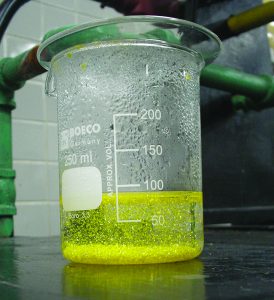Learning Objectives
By the end of this section, you will be able to:
- Define precipitation reactions
- Recognize and identify examples of precipitation reactions
Humans interact with one another in various and complex ways, and we classify these interactions according to common patterns of behavior. When two humans exchange information, we say they are communicating. When they exchange blows with their fists or feet, we say they are fighting. Faced with a wide range of varied interactions between chemical substances, scientists have likewise found it convenient (or even necessary) to classify chemical interactions by identifying common patterns of reactivity. The following sections of this chapter (section 6.2-6.4) will provide an introduction to three of the most prevalent types of chemical reactions: precipitation, acid-base, and oxidation-reduction.
Precipitation Reactions
A precipitation reaction is one in which dissolved substances react to form one (or more) solid products. Many reactions of this type involve the exchange of ions between ionic compounds in aqueous solution and are sometimes referred to as double displacement, double replacement, or metathesis reactions. These reactions are common in nature and are responsible for the formation of coral reefs in ocean waters and kidney stones in animals. They are used widely in industry for production of a number of commodity and specialty chemicals. Precipitation reactions also play a central role in many chemical analysis techniques, including spot tests used to identify metal ions and gravimetric methods for determining the composition of matter.
The extent to which a substance may be dissolved in water, or any solvent, is quantitatively expressed as its solubility, defined as the maximum concentration of a substance that can be achieved under specified conditions. Substances with relatively large solubilities are said to be soluble. A substance will precipitate when solution conditions are such that its concentration exceeds its solubility. Substances with relatively low solubilities are said to be insoluble, and these are the substances that readily precipitate from solution.
A vivid example of precipitation is observed when solutions of potassium iodide and lead nitrate are mixed, resulting in the formation of solid lead iodide:
This observation is consistent with expectations of solubility: The only insoluble compound among all those involved is lead iodide.
The net ionic equation representing this reaction is:
Lead iodide is a bright yellow solid that was formerly used as an artist’s pigment known as iodine yellow (Figure 1). The properties of pure PbI2 crystals make them useful for fabrication of X-ray and gamma ray detectors.

Example 1
Predict the result of mixing reasonably concentrated solutions of the following ionic compounds. Look up the formulas for polyatomic ions as needed. Write a balanced net ionic equation for the reaction.
a) potassium sulfate and barium nitrate. Barium sulfate is not water soluble.
b) lithium chloride and silver acetate. Silver chloride is not water soluble.
Solution
a) The two possible products for this combination are KNO3 and BaSO4. The net ionic equation for this reaction, derived in the manner detailed in the previous module, is
b) The two possible products for this combination are LiC2H3O2 and AgCl. The net ionic equation for this reaction, derived in the manner detailed in the previous module, is
Key Concepts and Summary
Chemical reactions are classified according to similar patterns of behavior. Precipitation is one type of chemical reaction which involves the formation of one or more insoluble products. Precipitation reactions, also called double displacement reactions can be summarized with the following reaction equation:
[latex]\text{AB}(aq) + \text{CD}(aq) \longrightarrow \text{AD}(s) + \text{CB}(aq) or (s)[/latex]
The formation of the solid is the DRIVING FORCE of the reaction (the factor that makes the reaction go).
A precipitation reaction can be predicted to occur with the help of a solubility table (Table 1). There are three ways of representing a precipitation reaction, using a molecular equation, complete ionic equation or net ionic equation, as described in section 6.1.
Review-Reflect, Extend
Review-Reflect
Assuming that each double replacement reaction occurs, predict the products and write each balanced chemical equation.
1. Zn(NO3)2 + NaOH [latex]\longrightarrow[/latex] ? Zinc hydroxide is insoluble.
2. HCl + Na2S [latex]\longrightarrow[/latex] ? Hydrogen sulfide is a gas that will escape water solution by bubbling out.
3. Pb(NO3)2 + KBr [latex]\longrightarrow[/latex] ? Lead bromide is insoluble.
4. K2O + Na2CO3 [latex]\longrightarrow[/latex] ? Potassium carbonate and sodium oxide are both soluble in water.
5. Na2CO3 + Sr(NO3)2 [latex]\longrightarrow[/latex] ? Strontium carbonate is insoluble.
6. (NH4)2SO4 + Ba(NO3)2 [latex]\longrightarrow[/latex] ? Barium sulfate is insoluble.
Extend
Charts showing solubility patterns for ionic compounds can be found on the web. Look at one of these charts and examine the periodic table. Are there any general patterns aligned with the solubility rules that are reflected in the organization of elements on the table?
Answers
1. Zn(NO3)2 + 2 NaOH [latex]\longrightarrow[/latex] Zn(OH)2 + 2 NaNO3
2. 2 HCl + Na2S [latex]\longrightarrow[/latex] 2 NaCl + H2S
3. Pb(NO3)2(aq) + 2 KBr(aq) [latex]\longrightarrow[/latex] PbBr2(s) + 2 KNO3(aq)
4. No reaction occurs.
5. Na2CO3(aq) + Sr(NO3)2(aq) [latex]\longrightarrow[/latex] 2 NaNO3(aq) + SrCO3(s)
6. (NH4)2SO4(aq) + Ba(NO3)2(aq) [latex]\longrightarrow[/latex] BaSO4(s) + 2 NH4NO3(aq)
Glossary
insoluble: of relatively low solubility; dissolving only to a slight extent
precipitate: insoluble product that forms from reaction of soluble reactants
precipitation reaction: reaction that produces one or more insoluble products; when reactants are ionic compounds, sometimes called double displacement or metathesis
salt: ionic compound that can be formed by the reaction of an acid with a base that contains a cation and an anion other than hydroxide or oxide
soluble: of relatively high solubility; dissolving to a relatively large extent
solubility: the extent to which a substance may be dissolved in water, or any solvent
